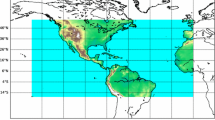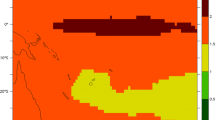Abstract
We have analyzed the tropical disturbances in a 11-layer atmospheric general circulation model (GCM) on a 2.5° × 3.75° horizontal grid coupled to a 50 m-mixed layer ocean. Due to the coarse resolution, the GCM is unable to resolve adequately tropical cyclones. The tropical disturbances simulated by the GCM are much weaker and have a much larger horizontal extent. However, they still display much of the essential physics of tropical cyclones, including low-level convergence of mass and moisture, upper tropospheric outflow and a warm core. For most ocean basins the spatial and temporal distribution of the simulated tropical disturbances compares well with the observed tropical cyclones. On doubling the CO2 concentration, the number of simulated tropical disturbances increases by about 50%. There is a relative increase in the number of more intense tropical disturbances, whose maximum windspeed increases by about 20%. This agrees with the theoretical estimate of Emanuel. However, because the low-resolution of the GCM severely restricts their maximum possible intensity, simulated changes in tropical disturbance intensity should be interpreted cautiously.
Similar content being viewed by others
References
Anthes RA (1977) Hurricane model experiments with a new cumulus parameterization scheme. Mon Wea Rev 105:287–300
Anthes RA (1982) Tropical cyclones, their evolution, structure and effects. Meteorology monographs, 19. Amer Meteor Soc, Boston, Mass
Bengtsson L, Bottger H, Kanamitsu M (1982) Simulation of hurricane-type vortices in a general circulation model. Tellus 34:440–457
Broccoli AJ, Manabe S (1990) Can existing climate models be used to study anthropogenetic changes in tropical cyclone climate? Geophys Res Lett 17:1917–1920
Emanuel KA (1986) An air-sea interaction theory for tropical cyclones. I. Steady-state maintenance. J Atmos Sci 43:585–604
Emanuel KA (1987) The dependence of hurricane intensity on climate. Nature 326:483–85
Frank WM (1977) The structure and energetics of the tropical cyclone. II. Dynamics and energetics. Mon Weather Rev 105:1136–1150
Gray WM (1979) Hurricanes: their formation, structure and likely role in the tropical circulation. In: Shaw OB (ed) Meteorology over the tropical oceans. R Meteorol Soc, London, pp 155–218
Gray WM (1988) Environmental influences on tropical cyclones. Aust Meteorol Mag 36:127–139
Gregory D, Rowntree PR (1990) A mass flux convection scheme with representation of cloud ensemble characteristics and stability-dependent closure. Mon Weather Rev 118:1483–1506
Heymsfield AJ (1977) Precipitation development in stratiform ice clouds: a microphysical and dynamical study. J Atmos Sci 34:367–381
Heymsfield AJ, Sabin RM (1989) Cirrus crystal nucleation by homogeneous freezing of solution droplets. J Atmos Sci 46:2252–2264
Holland GJ, McBride JL, Nicholls N (1989) Australian region tropical cyclones and the greenhouse effect. Greenhouse Planning for Climate change, CSIRO, Australia
IPCC (1990) Climate change, the IPCC Scientific Assessment. Cambridge University Press
Krishnamurti TN (1988) Some recent results on numerical weather prediction over the tropics. Aust Meteorol Mag 36:141–170
Krishnamurti TN, Oosterhof D (1989) Prediction of the life cycle of a super-typhoon with a high-resolution global model. Bull Am Meteorol Soc 70:1218–1230
Manabe S, Holloway JL, Stone HM (1970) Tropical circulation in a time-integration of a global model of the atmosphere. J Atmos Sci 27:580–613
McBride JL, Zehr R (1981) Observational analyses of tropical cyclone formation. II. Comparison of non-developing versus developing systems. J Atmos Sci 38:1132–1151
Merrill RT (1987) An experiment in the statistical prediction of tropical cyclone intensity change. Volume of extended astracts, 17th Conference on Hurricanes and Tropical Meteorology. American Meteorology Society, Boston, pp 302–304
Mitchell JFB, Ingram W (1992) On CO2 and climate: mechanisms of change in cloud. J Clim 5:5–21
Mitchell JFB, Slingo A (1988) Climatic effects of nuclear war: the role of atmospheric stability and ground heat fluxes. J Geophys Res 93:7037–7045
Mitchell JFB, Ingram W, Senior CA (1989) CO2 and climate: a missing feedback? Nature 341:132–134
Ooyama KV (1969) Numerical simulations of the life cycle of tropical cyclones. J Atmos Sci 26:3–40
Raper SCB (1990) Observational data on the relationships between climatic change and the frequency and magnitude of severe tropical storms. In: Warrick RA, Wigley TML (eds) Climate and sea level change: observations, projections, implications. Cambridge University Press
Reed RJ, Hollingsworth A, Heckley WA, Delsol F (1986) An evaluation of the performance of the ECMWF operational forecasting system in analysing and forecasting tropical easterly wave disturbances. 1. Synoptic investigation. ECMWF Technical Report no 58, ECMWF, Reading, UK
Rotunno R, Emanuel KA (1987) An air-sea interaction theory for tropical cyclones. II. Evolutionary study using a non-hydrostatic axisymmetric model. J Atmos Sci 44:542–562
Smith RNB (1990) A scheme for predicting layer clouds and their water content in a general circulation model. Quat J Roy Meteor Soc 116:435–460
Wilson CA, Mitchell JFB (1987) A doubled CO2 climate sensitivity experiment with a global climate model including a simple ocean. J Geophys Res 92:13315–13343
Author information
Authors and Affiliations
Rights and permissions
About this article
Cite this article
Haarsma, R.J., Mitchell, J.F.B. & Senior, C.A. Tropical disturbances in a GCM. Climate Dynamics 8, 247–257 (1993). https://doi.org/10.1007/BF00198619
Received:
Accepted:
Issue Date:
DOI: https://doi.org/10.1007/BF00198619




